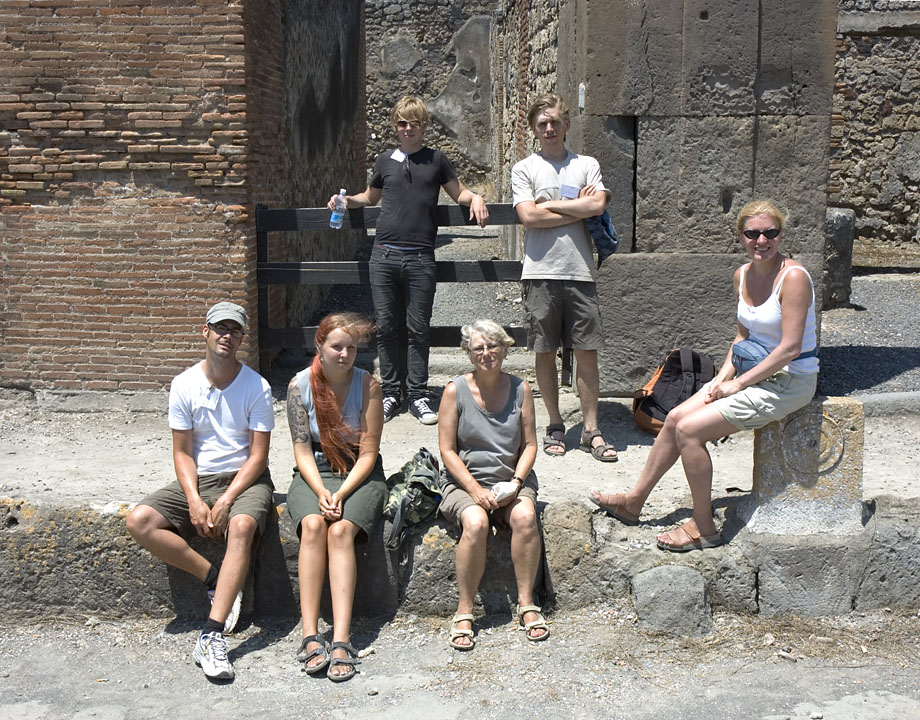Field Campaign 2008
Prof. Anne-Marie Leander, SU: project director
Doc Arja Karivieri, SU: joint field director
FD Renée Forsell, LU: joint field director
Thomas Staub, SU, stationed at Archäologisches Institut, Albert-Ludwigs-Universität, Freiburg: archaeologist
Hans Thorwid, photographer
Jesper Blid, SU: draughtsperson
Adam Lindhagen, SU: amphora specialist
Mats Bergman, assistant
Linus Söderlund, SU: trainee
Susanna Salminen, GU: trainee
Jonathan Wahlström, SU: trainee
Michel Hagedorn, volunteer
Abstract:
Three houses were in focus during the campaign of 2008: Renée Forsell commenced the investigation of Building complex V 1,3, Anne-Marie Leander Touati initiated work in Casa di Tofelanus Valens (V 1,28) and Thomas Staub concluded much of his study of Casa del Torello di bronzo(V 1,7).
Work in Building complex V 1,3
The small atrium house V 1,3 is located at Via di Nola. The study was carried out by Forsell with the primary goal to document the use of water in the building and, if possible, establish where the aqueduct water entered the house. The investigation was concentrated to the atrium and the three small rooms opening on to the atrium to the west. The documentation of walls and floors of the three small rooms 5, 6 and 7 was made by the students as part of their examination assignment.
A water distribution box, located near the northwestern corner of the impluvium, had previously been noticed by Staub and an area without any remains of ancient floor was therefore cleared in the northwestern part of the atrium. A led water pipe was found just two to five cm below what should have been floor level, running from northwest towards the distribution box. From here the water was distributed to three pipes leading the water towards the east, to the impluvium and to the south. Of these only the eastgoing pipe still remained and only in part, along the northern side of the impluvium.
The investigation continued in the area around the impluvium, along the northwestern wall of the atrium and in the fauces. An intriguing system of water conduits and cisterns was revealed where the aqueduct water, after passing through the fountains and filling the cisterns of the house, was led to the cisterns in Tabernae V 1,4 and V 1,31.
Work in Casa del Torello di bronzo (V 1,7)
The study of Casa del Torello di bronzo by Staub is drawing to an end and he now concluded all documentation of masonry and wall decorations and he also studied the possible locations of the rooms above the western part of the atrium, the eastern part of the peristyle and above the economy quarters. Thorwid photographed and Blid drew plans of the peristyle and of rooms e and g where some cleaning and excavation took place. In room g the eastern part was excavated down to a floor level earlier than that of AD 79. Room e was part of the economy quarters and its southern half may possibly have functioned as industrial premises, whereas the northern half had a latrina and a basin fitted in.
Work in Casa di Tofelanus Valens (V 1,28)
Preliminary investigations were started in Casa di Tofelanus Valens by Leander Touati. The aim was to locate the ingoing water pipe that fed the monumental fountain of Casa del Torello di bronzo and two investigation areas were therefore of special interest. The first was a rectangular area, 2 x 1m, in the largest of the northern rooms (d) and the second was the space in front of a walled up door opening in the eastern wall of room b. The door had once led into the room that later became the kitchen of Casa del Torello di bronzo.
We can now reject the idea that the water came from the south through V 1,3, but the investigated areas of Casa di Tofelanus Valens gave no conclusive answer. The work in room d had to be aborted as it turned out that the whole area was covered with a very dense packing of building debris, probably from a building that had been torn down in an earlier phase, and there was no time this year to remove it. In room b there were no such obstacles, but neither were there any signs of water conduits.
Other activities
Karivieri and Forsell also did complementary documentation in Casa di Caecilius Iucundus and Annex (V 1,23 and V 1,26). The floor of the tablinum was now studied, a task which had not been possible earlier since the mosaic had been covered for quite some time.
Thorwid continued the photographic documentation of the walls of the insula and the finds. Lindhagen came to study the amphorae found in a cesspit in Taberna V 1,24 during the excavations in 2006 and now stored in the Forum deposit.
Report: Renée Forsell
Edited and translated into English by Monica Nilsson

